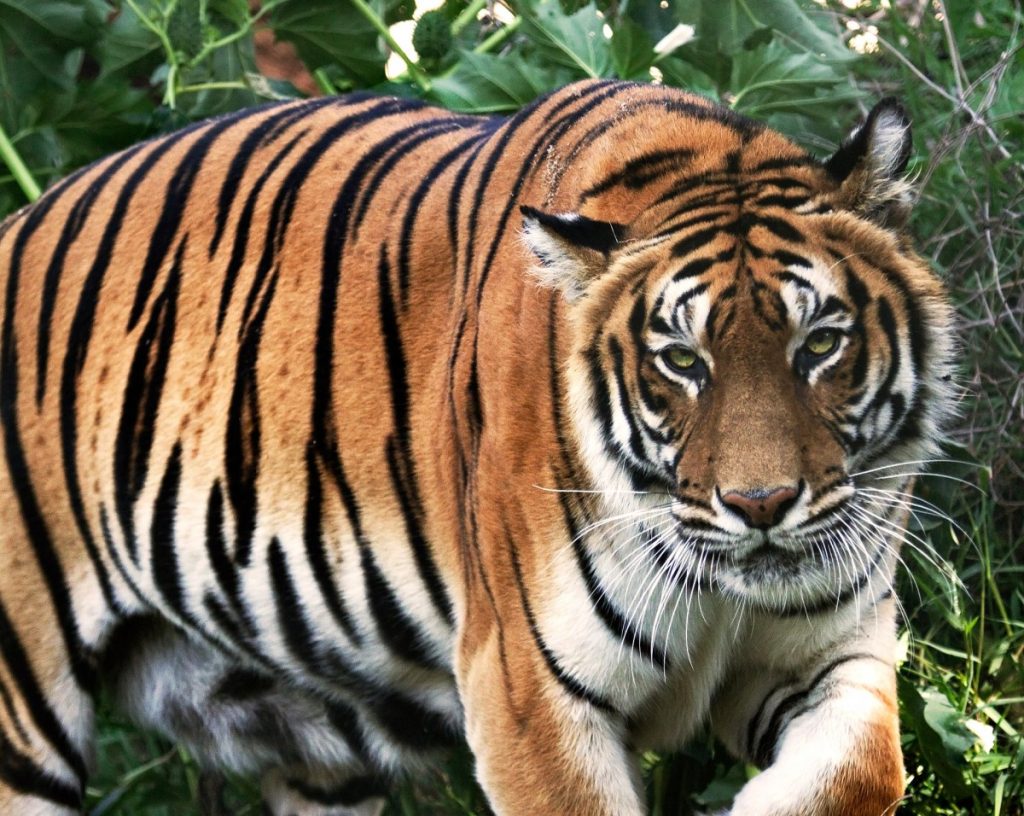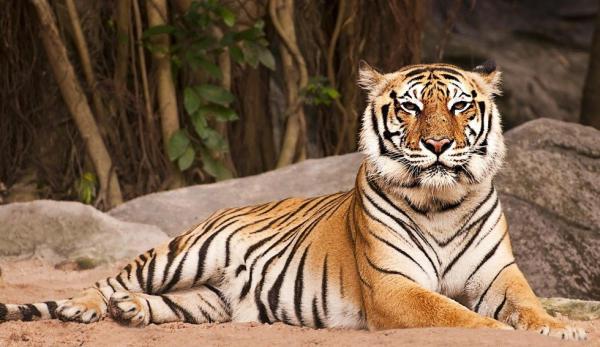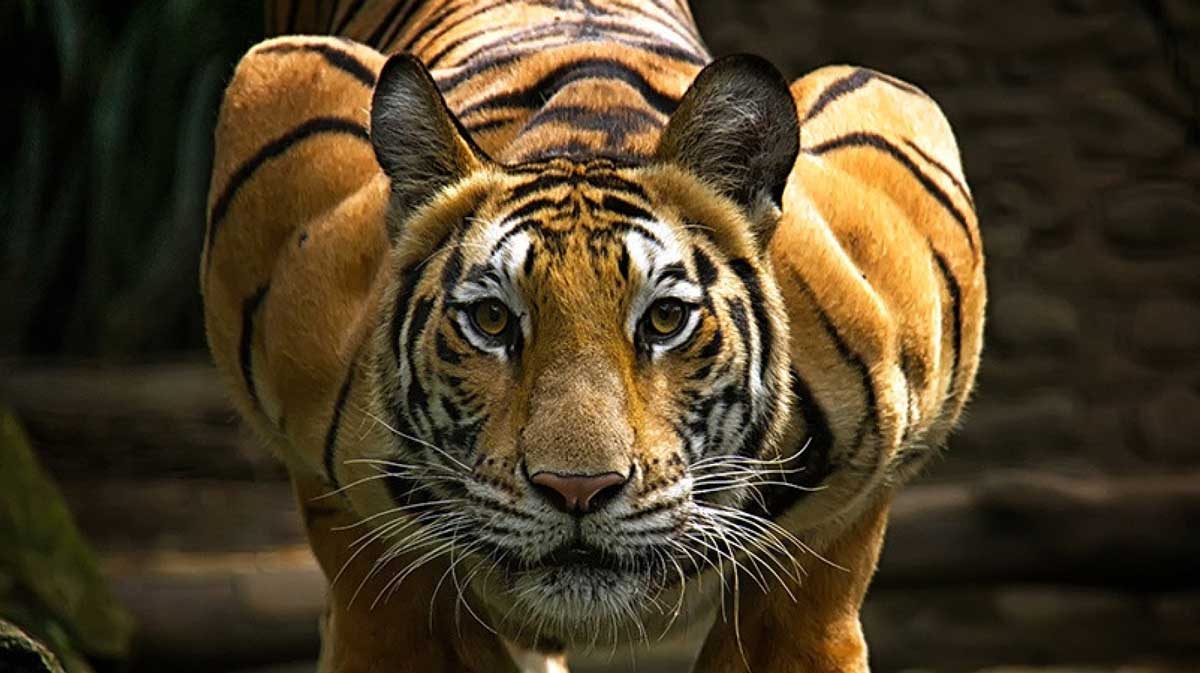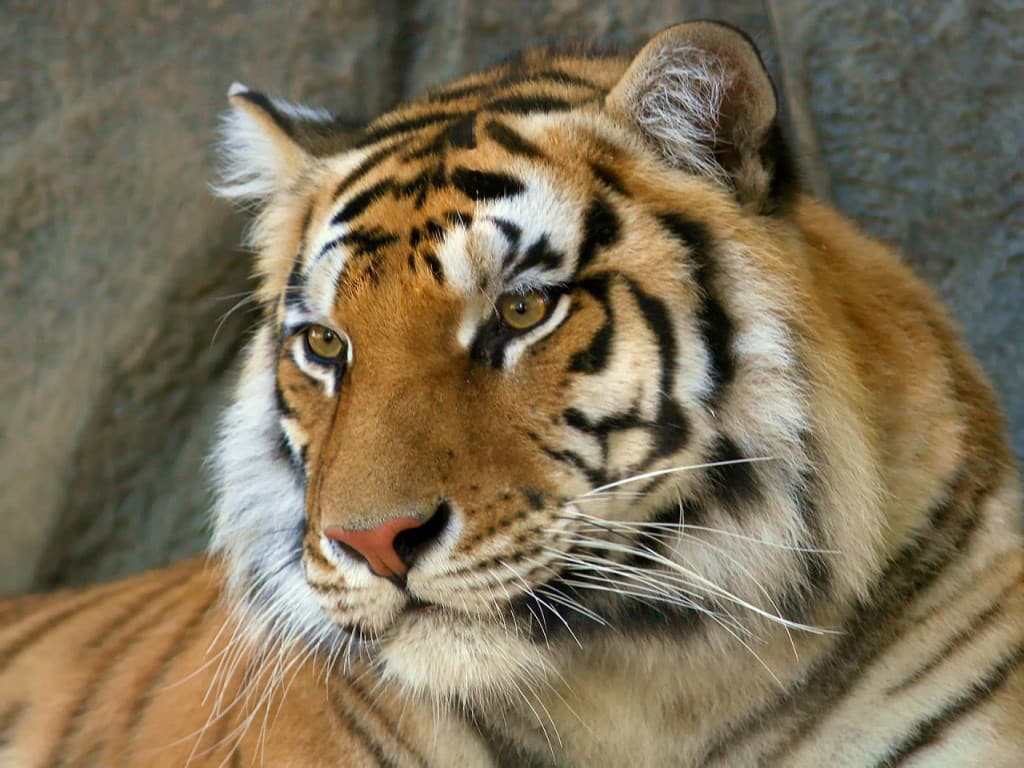El Bengal tiger, are animals recognized in the countries of India, Nepal and Bangladesh and throughout Asia as a symbol of strength and power. It is the largest and strongest of the felines, they are very aggressive animals due to their survival instinct.

Characteristics of the Bengal Tiger
panthera tigris tigris scientific name of the Bengal Tigers or and in most of its subspecies, they are characterized by having the body covered with stripes, ranging from light brown to black. The number of stripes is between one hundred (100) and one hundred and fifty (150), the width and the distance between them vary according to the species, for example El Tigre from Sumatra is the one with the most stripes, while the one from Siberia has the fewest.
The stripes have the function of serving as camouflage and thus blend in with the vegetation, the stripes are like fingerprints, that is, no two tigers have them the same.
Bengal tiger fur
The color of the hair is very characteristic, it goes from light yellow to bright orange, it should be noted that white tigers are not albinos, they are bengal tigers in which the yellow color has been replaced by white. Others, in the same way , are known as golden tigers, product of another mutation, but these are only seen in captivity these are some bengal tiger photos
Bengal Tiger Size
Currently, it is shown to be the largest feline species in the world, where the male has a length of 2,70 meters to 3,10 meters and the females have a smaller size of 2,40 meters to 2,65 meters. this size is the length of its body without tail, which can measure between 85 centimeters and 1 meter long. As for the height from the shoulders to the ground, it is 90 centimeters and 1,10 meters.
The tiger's tail is used as a rudder when they jump. It also helps them balance by turning when running at high speeds.
Weight, Beauty and Power
The weight of some tigers is below one hundred (100) kg while others reach two hundred and thirty (230) kg in the case of males and depending on the region they inhabit. Females of this species can weigh up to one hundred thirty-one (131) kg. A large male from Ranthambore National Park was known, which killed four people between 2010 and 2015, which reached two hundred and fifty (250) kg in weight.
Tigers are very strong and agile. They also have a super flexible body and a great speed of reflexes. That is why they are such feared hunters. Eyesight is very sharp, his eyes are dark-adaptive. At night a tiger sees five times better than a human being.
The Bengal tiger does not usually run long distances. Theirs are short and fast races, in which they reach 55 km/h.
Review
According to Guinness World Records, the largest known Bengal tiger was a male hunted in 1967; which measured three hundred twenty-two (322) cm and weighed three hundred eighty-eight (388) kg. But scientifically the weight does not seem correct to them since its measurements do not coincide with its weight and in the photographic evidence the tiger did not appear large, so it is very possible that its real weight is much lower, the specimen was hunted at North India by David Hasinger of Philadelphia Industry.
Currently, this specimen is dissected and exhibited at the Smithsonian Institution, in the Hall of Mammals. At the beginning of the 360th century there was evidence where male specimens reached three hundred and sixty (XNUMX) cm in total length; however, there is no scientific proof of such sizes and it is most likely that they were measured on the curves of the back.
The Great Hunter Diet
La tiger feeding Bengal consist of carnivorous and hunt all kinds of Wild animals , such as Asian buffalo, deer, antelope, wild pigs in general, large herbivores are the favorite prey of tigers. They also feed on small animals such as birds and monkeys. After eating, the tiger dedicates itself to cleaning itself with the help of its tongue.
Although it is not normal, sometimes there are cases traditional cases in which tigers have attacked rhinoceros calves and elephant, and included of individuals who were able to shoot down y to bite to other large carnivores such as leopards, male jaguars that reach 1000 kg of weight and even bears.
These animals rarely attack humans, but in a season a few centuries ago they occurred more frequently, but these attacks were made by old and/or sick animals that were less likely to hunt other prey.
Approximately 100 attacks per year have been recorded in the Bangladesh area.
In some areas the tiger watches that the crocodiles do not attack him while he drinks water, when hunger strikes the tiger does not disgust anything and can eat lizards, frogs, insects and even carrion animals. A tiger can eat up to forty (40) kg of meat in a single day.
Lethal Technique
Although they seem very violent, the fights between tigers do not usually end with the death of any of them. Tigers hunt alone, since in places with a lot of vegetation it is more difficult to attack in groups, despite being such good hunters, it is estimated that for each successful hunt they fail ten (10) to twenty (20) times.
The tigers approach their prey without making the least noise, they wait crouched. When they are close, they run at high speed until reaching them with a powerful jump. Its sharp fangs and claws do the rest. They usually hunt at night to take advantage of the darkness and their prey are also less active.
Where they live?
Tigers live in very varied environments: jungles, forests, grassy plains, swampy areas. The only thing they need is water, enough prey and vegetation to shelter. Tigers love water. In warm areas, they usually take continuous baths to cool off. The Bengal tiger is a very good swimmer. It is capable of crossing rivers and lakes of more than six (6) km, it is something similar as if you will swim 140 pools.
The Tigers flee from the open grasslands. They prefer forests and tall grassy areas, as it is easier for them to hunt.
It is important to say that a large number of the Bengal Tiger population, which represents a third of this species worldwide, lives in the national parks of India and Bangladesh. There is also a significant population in Nepal, in the Royal Chitwan National Park.
In general, the Bengal Tiger can live both in cold places and in very hot regions. There are also species that are found in high mountains.
Territorial Animals
Unlike other felines, such as lions, Bengal tigers and their subspecies, they do not form social groups, they are solitary animals. The only times they are in company is during the mating period. Females, on the other hand, travel with their young in groups of three or four.
The males guard a territory where several females live with whom they mate. They scratch trees to mark it and the height of the mark indicates how big the tiger is. Cases have sometimes been reported of males feeding their young when the mother dies.
Reproduction of the Bengal Tiger
In the world of tigers, the male and female spend about 6 or 7 days together to complete mating.
The heat is varied depending on the area, the environment and/or the climate in which the tigers are living.
Its reproduction is classified as viviparous and the gestation time is three to four months. The tiger is sexually mature when it is 4 or 5 years old.
The tigress looks for a protected place to give birth, the cubs are born blind weighing only 1 kg, but these tiny cubs weigh more than 90 kg after a year, it is usually a litter of two or three cubs. Newborns feed only on mother's milk until they are two months old, remaining with their puppies for almost two years.
From two months of age, the little tigers are capable of following their mother on their expeditions, moving their little ones with care to protect them from predators. After five months they begin to participate in hunts and the tigress teaches them all the secrets to stay on the lookout and learn to hunt. The fights between brothers help them to become stronger and faster, which serves as learning for survival.
From the age of two, tigers can catch prey on their own. It is when they separate from their mother and go to live alone.
The subspecies that have survived
Throughout the XNUMXth century, three subclasses of tiger became extinct, grouping the Bengal, Siberian, Indochinese, South China, Malayan tigers, as well as the extinct Caspian tiger and the Sunda tigers (panthera tigris sondaica) that groups the Sumatran tiger as well as the now extinct Javan and Bali tigers.
Currently, there are five subspecies of tigers. Although they are very similar, they show small differences between them, depending on the climate and vegetation of the region where they live. Most of the Tigers are from Bengal, which are the ones that live in India.
Next we are going to mention the four subspecies of tigers that exist:
indochinese tiger
It closely resembles the Bengal, but is slightly smaller and with a darker coat color.
Sumatra tiger
They are the smallest, being this one 2,30 meters long and weighing 120 Kg and the color of their hair is more orange.
Siberian Tiger
It is the largest reaching two hundred and five (205) Kg, with a length of 1,95 meters and the coat is thicker. This is because it lives in a large, cold region in northern Asia.
South China Tiger
It is believed that there are only twenty (20) specimens left in the wild, their size is 2,60 meters and they weigh about one hundred and ten (110) Kg. The stripes of this subspecies are wide, they are more separated than in other specimens of tigers. , I give his coat a wonderful and impressive appearance.
Bengal Tiger Conservation
At the beginning of the 100.000th century there were one hundred thousand (5.000) tigers in the wild, today it is believed that there are only between five thousand (7.000) and seven thousand (XNUMX) specimens left.
Tigers are at serious risk of disappearing, thanks to the growth of the human population in the world and as a consequence, fewer natural spaces in which they can live. As they are fewer and more separated, tigers have a harder time finding a mate to reproduce.
In addition to poaching, although it is illegal, tigers are still being killed for their beautiful fur. Many tigers are hunted for traditional Chinese medicine, where various parts of the tiger are used in their therapy, such as: whiskers, nails, which are supposedly used to cure different diseases.
Most Bengal tigers live in nature reserves and parks. Zoos also have the mission of protecting the species in conjunction with world organizations such as the World Wildlife Fund whose function is to stop poaching and reduce the constant dangers to which said animal is exposed. As of 2014 the Bengal tiger population in India was around 2.226 tigers.




